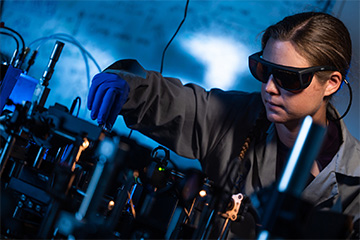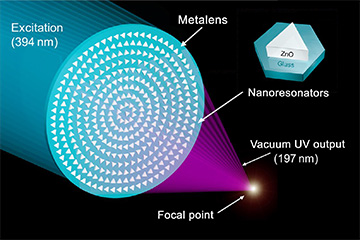
Rice University graduate student Catherine Arndt helped create a solid-state “metalens” that transforms long-wave UV into focused vacuum UV (VUV) radiation. [Image: J. Fitlow/Rice University]
Vacuum ultraviolet (VUV) light—the spectral region from 100 to 200 nm, strongly absorbed by atmospheric oxygen—is complicated for scientists to use, largely because most lens materials won’t transmit the light. Researchers also need large, expensive excimer lasers to generate VUV radiation, although solid-state lasers with nonlinear optics have made some inroads into the region.
Now, an international team of researchers has developed a VUV lens that uses the principles of metasurfaces and metamaterials to simultaneously generate and focus VUV light (Sci. Adv., doi: 10.1126/sciadv.abn5644). Second-harmonic generation within the “metalens” converts longer-wavelength UV rays to the VUV range and focuses the rays into a tight spot less than 2 μm in diameter.
Building a wavelength-shortening lens
VUV light has many applications in chemistry and materials science, and, in particular, the manufacture of metasurfaces compatible with complementary metal-oxide-semiconductor (CMOS) technology. However, “The VUV region of the spectrum is underused due to the challenge of developing high-performance optics for this region of the spectrum, as well as a lack of compact coherent sources,” says Optica Fellow Naomi J. Halas, a professor at Rice University, USA, specializing in nanophotonics. Focusing these short wavelengths into a narrow, powerful beam has required lenses made of comparatively fragile materials such as calcium fluoride.
Halas and her team designed a metalens consisting of tiny equilateral triangles of zinc oxide arranged in a hexagonal lattice on a glass substrate. Each of the tiny triangles, or “meta-atoms,” had an edge length of 205 nm and a thickness of 150 nm, while the lattice constant was 270 nm. The meta-atoms needed to have C3 rotational symmetry for second-harmonic generation under circularly polarized illumination.

By etching hundreds of tiny triangular nanoresonators in precisely configured concentric circles on a microscopic film of zinc oxide, researchers created a “metalens,” a transparent, solid-state device thinner than a sheet of paper that bends light like a conventional lens. The metalens converts 394-nm ultraviolet light (blue) into 197-nm VUV (pink) and simultaneously focuses the VUV output on a small spot less than 2 μm in diameter. [Image: M. Semmlinger/Rice University] [Enlarge image]
When the 394-nm light from a laser enters the metalens, it converts the radiation via second-harmonic generation to a wavelength of 197 nm. It also focuses the radiation down to a spot 1.7 μm across, enhancing the light’s power density by 21 times. Halas notes that the metalens combines nonlinear frequency generation and focusing of the resulting light—processes that typically require a system of components—into a single optical component.
Opening door for future laser sources
“The nanofabrication required for such high-precision, short-wavelength optics is approaching current fundamental technological limitations,” Halas says. But she predicts that this new type of VUV optics will open the door for laser developers to create lightweight, compact short-wavelength laser sources that could eventually replace excimer lasers.
Researchers from three universities in Taiwan and one university in Hong Kong also contributed to this work.
